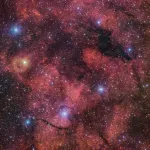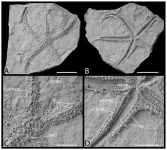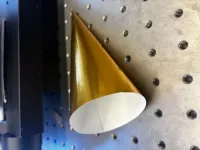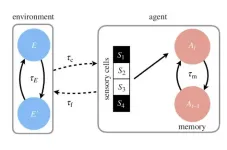(Press-News.org) For Halloween, the European Southern Observatory (ESO) reveals this spooktacular image of a dark nebula that creates the illusion of a wolf-like silhouette against a colourful cosmic backdrop. Fittingly nicknamed the Dark Wolf Nebula, it was captured in a 283-million-pixel image by the VLT Survey Telescope (VST) at ESO’s Paranal Observatory in Chile.
Found in the constellation Scorpius, near the centre of the Milky Way on the sky, the Dark Wolf Nebula is located around 5300 light-years from Earth. This image takes up an area in the sky equivalent to four full Moons, but is actually part of an even larger nebula called Gum 55. If you look closely, the wolf could even be a werewolf, its hands ready to grab unsuspecting bystanders…
If you thought that darkness equals emptiness, think again. Dark nebulae are cold clouds of cosmic dust, so dense that they obscure the light of stars and other objects behind them. As their name suggests, they do not emit visible light, unlike other nebulae. Dust grains within them absorb visible light and only let through radiation at longer wavelengths, like infrared light. Astronomers study these clouds of frozen dust because they often contain new stars in the making.
Of course, tracing the wolf’s ghost-like presence in the sky is only possible because it contrasts with a bright background. This image shows in spectacular detail how the dark wolf stands out against the glowing star-forming clouds behind it. The colourful clouds are built up mostly of hydrogen gas and glow in reddish tones excited by the intense UV radiation from the newborn stars within them.
Some dark nebulae, like the Coalsack Nebula, can be seen with the naked eye –– and play a key role in how First Nations interpret the sky [1] –– but not the Dark Wolf. This image was created using data from the VLT Survey Telescope, which is owned by the National Institute for Astrophysics in Italy (INAF) and is hosted at ESO’s Paranal Observatory, in Chile’s Atacama Desert. The telescope is equipped with a specially designed camera to map the southern sky in visible light.
The picture was compiled from images taken at different times, each one with a filter letting in a different colour of light. They were all captured during the VST Photometric Hα Survey of the Southern Galactic Plane and Bulge (VPHAS+), which has studied some 500 million objects in our Milky Way. Surveys like this help scientists to better understand the life cycle of stars within our home galaxy, and the obtained data are made publicly available through the ESO science portal. Explore this treasure trove of data yourself: who knows what other eerie shapes you will uncover in the dark?
Notes
[1] The Mapuche people of south-central Chile refer to the Coalsack Nebula as ‘pozoko’ (water well), and the Incas called it ‘yutu’ (a partridge-like bird).
More information
The European Southern Observatory (ESO) enables scientists worldwide to discover the secrets of the Universe for the benefit of all. We design, build and operate world-class observatories on the ground — which astronomers use to tackle exciting questions and spread the fascination of astronomy — and promote international collaboration for astronomy. Established as an intergovernmental organisation in 1962, today ESO is supported by 16 Member States (Austria, Belgium, Czechia, Denmark, France, Finland, Germany, Ireland, Italy, the Netherlands, Poland, Portugal, Spain, Sweden, Switzerland and the United Kingdom), along with the host state of Chile and with Australia as a Strategic Partner. ESO’s headquarters and its visitor centre and planetarium, the ESO Supernova, are located close to Munich in Germany, while the Chilean Atacama Desert, a marvellous place with unique conditions to observe the sky, hosts our telescopes. ESO operates three observing sites: La Silla, Paranal and Chajnantor. At Paranal, ESO operates the Very Large Telescope and its Very Large Telescope Interferometer, as well as survey telescopes such as VISTA. Also at Paranal ESO will host and operate the Cherenkov Telescope Array South, the world’s largest and most sensitive gamma-ray observatory. Together with international partners, ESO operates ALMA on Chajnantor, a facility that observes the skies in the millimetre and submillimetre range. At Cerro Armazones, near Paranal, we are building “the world’s biggest eye on the sky” — ESO’s Extremely Large Telescope. From our offices in Santiago, Chile we support our operations in the country and engage with Chilean partners and society.
Links
Photos of the survey telescopes at Paranal, including VST
For journalists: subscribe to receive our releases under embargo in your language
For scientists: got a story? Pitch your research
Contacts
Juan Carlos Muñoz Mateos
ESO Media Officer
Garching bei München, Germany
Tel: +49 89 3200 6176
Email: jmunoz@eso.org
Bárbara Ferreira
ESO Media Manager
Garching bei München, Germany
Tel: +49 89 3200 6670
Cell: +49 151 241 664 00
Email: press@eso.org
END
New ESO image captures a dark wolf in the sky
2024-10-31
ELSE PRESS RELEASES FROM THIS DATE:
New research reveals delayed evolutionary origin of Asteriidae sea stars
2024-10-31
A study published in PeerJ Life and Environment has reshaped our understanding of the evolutionary history of sea stars, particularly the family Asteriidae. The study, titled Phylogenetic and taxonomic revisions of Jurassic sea stars support a delayed evolutionary origin of the Asteriidae, introduces new findings that challenge longstanding assumptions about the evolutionary timeline of these marine invertebrates.
Sea stars of the superorder Forcipulatacea, comprising approximately 400 species, are integral ...
A paper-aluminum combo for strong, sustainable packaging
2024-10-31
Takeout containers get your favorite noodles from the restaurant to your dining table (or couch) without incident, but they are nearly impossible to recycle if they are made from foil-lined plastics. Research published in ACS Omega suggests that replacing the plastic layer with paper could create a more sustainable packaging material. The researchers used mechanical demonstrations and computer simulations to identify paper-aluminum laminate designs that won’t compromise on performance.
Protective packaging, like containers made ...
A novel neural network for preserving cultural heritage via 3D image reconstruction
2024-10-31
Relief carvings or relief sculptures are cultural heritage objects with figures that protrude from a background such as a wall or slab, creating a sense of depth. Commonly found at historical sites worldwide, these artworks are considered to be of immense historical and cultural value. Unfortunately, many such relief carvings at heritage sites across the world suffer from varying degrees of damage and deterioration over time. While modern 3D scanning and photogrammetry techniques can digitally preserve their current form, they cannot restore the original appearance of these carvings before damage. Additionally, traditional methods for restoring ...
Sleep apnea contributes to dementia in older adults, especially women
2024-10-31
A common yet underdiagnosed sleep disorder contributes to the development of dementia among adults — particularly women, a Michigan Medicine study suggests.
Investigators uncovered this by examining survey and cognitive screening data from more than 18,500 adults to determine the potential effect of known or suspected obstructive sleep apnea on the risk for dementia.
Obstructive sleep apnea is a chronic sleep disorder characterized by episodes disrupted or restricted breathing during sleep.
For all adults age 50 and older, having known obstructive sleep apnea or its symptoms — as people often do not know they have the problem ...
The silk thread that can turn clothes into charging stations
2024-10-31
Imagine a sweater that powers electronics to monitor your health or charge your mobile phone while running. This development faces challenges because of the lack of materials that both conduct electricity stably and are well suited for textiles. Now a research group, led by Chalmers University of Technology in Sweden, presents an ordinary silk thread, coated with a conductive plastic material, that shows promising properties for turning textiles into electricity generators.
Thermoelectric textiles convert temperature differences, for example between our bodies and the surrounding ...
Glaucoma drug shows promise against neurodegenerative diseases, animal studies suggest
2024-10-31
A drug commonly used to treat glaucoma has been shown in zebrafish and mice to protect against the build-up in the brain of the protein tau, which causes various forms of dementia and is implicated in Alzheimer’s disease.
Researchers in the UK Dementia Research Institute at the University of Cambridge screened more than 1,400 clinically-approved drug compounds using zebrafish genetically engineered to make them mimic so-called tauopathies. They discovered that drugs known as carbonic anhydrase inhibitors – of which the glaucoma drug methazolamide is one – clear tau build-up and reduce signs of the disease in zebrafish and mice carrying the mutant forms of tau ...
Human proteins identified that explain inter-individual differences in functional brain connectivity
2024-10-31
BIRMINGHAM, Ala. – A long-standing goal of neuroscience is to understand how molecules and cellular structures on a microscale give rise to communication between brain regions at the macroscale. A study published in Nature Neuroscience now identifies, for the first time, hundreds of brain proteins that explain inter-individual differences in functional connectivity and structural covariation in the human brain.
“A central goal of neuroscience is to develop an understanding of the brain that ultimately describes the mechanistic basis of human cognition and behavior,” said Jeremy Herskowitz, Ph.D., associate professor in the University of Alabama at Birmingham ...
A newly developed algorithm shows how a gene is expressed at microscopic resolution
2024-10-31
They say a picture is worth a thousand words.
A new method, developed by University of Michigan researchers, creates images that are worth many gigabytes of data, which could revolutionize the way biologists study gene expression. Seq-Scope, developed by Jun Hee Lee, Ph.D., Hyun Min Kang, Ph.D., and their colleagues, was first described in Cell in 2021 as the first method to analyze gene expression at sub micrometer-scale spatial resolution.
To compare, a single human hair ranges from 20 to 200 micrometers in width.
The team has since improved Seq-Scope, making it more versatile, ...
Why elephants never forget but fleas have, well, the attention span of a flea
2024-10-31
Researchers at the Complexity Science Hub and Santa Fe Institute have developed a model to calculate how quickly or slowly an organism should ideally learn in its surroundings. An organism’s ideal learning rate depends on the pace of environmental change and its life cycle, they say.
Every day, we wake to a world that is different, and we adjust to it. Businesses face new challenges and competitors and adapt or go bust. In biology, this is a question of survival: every organism, from bacteria to blue whales, faces the challenge of adapting to environments that ...
Childhood neglect associated with stroke, COPD, cognitive impairment, and depression
2024-10-31
Toronto, ON, – New research from the University of Toronto found that childhood neglect, even in the absence of childhood sexual abuse and physical abuse, is linked with a wide range of mental and physical health problems in adulthood.
“While a large body of research has established the detrimental impact of childhood physical and sexual abuse on adult health outcomes, much less is known about whether neglect, in the absence of abuse, has similar negative outcomes,” said first author, Linxiao Zhang, a PhD student at the Factor-Inwentash Faculty of Social Work (FIFSW) at the University of Toronto. “Our research underlines the importance of health professionals ...






